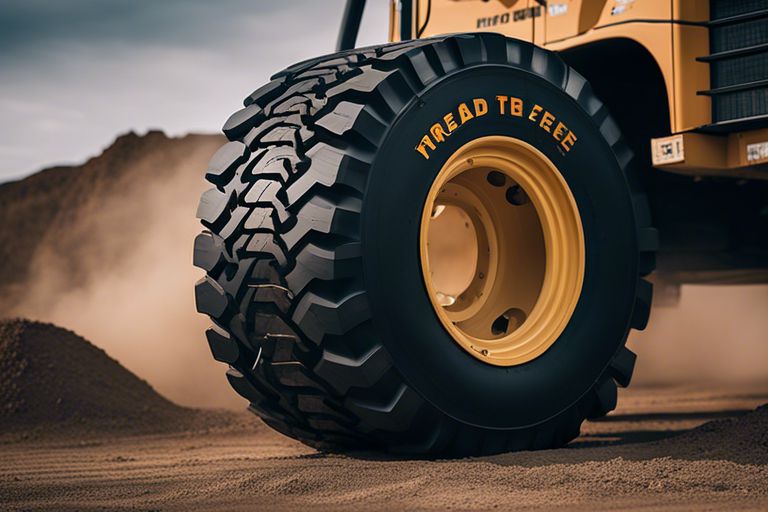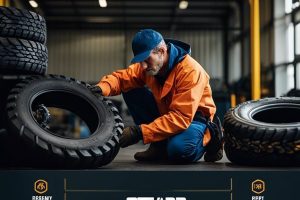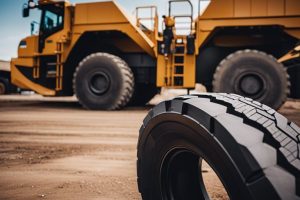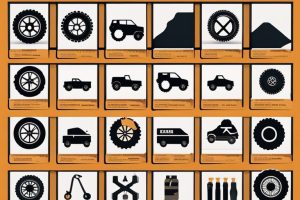Discovering the ideal off-the-road (OTR) tires are crucial for any professional in the construction, mining or agricultural sectors. Selecting the right OTR tires can make a significant difference in terms of performance, safety and overall efficiency of heavy equipment. In this comprehensive guide, we'll take a closer look at the most important factors to consider when choosing OTR tires, from size and tread pattern to ply thickness and compound. Equip yourself with the knowledge needed to create informed decisions that not only maximize the life of your tires, but also optimize the productivity of your heavy machinery.
Key learning points:
- Understand your needs: Before selecting OTR tires, analyze the terrain, payload, weather conditions and industry requirements to ensure you choose the right tire for the job.
- Consider tire properties: Pay attention to important features such as tread pattern, depth, carcass durability and sidewall protection to ensure optimal performance and long life of the OTR tires.
- Consult experts: Consult tire professionals or manufacturers to get personalized recommendations based on your specific needs and budget constraints when selecting OTR tires for your heavy-duty equipment.
Understanding OTR Bands
When shopping for Off-the-Road (OTR) tires, it's crucial that you have a good understanding of the different types available and the key components and technologies that determine their performance. OTR tires are specially designed for heavy vehicles that travel on paved roads and challenging terrains. These tires are a crucial part of construction, mining, agricultural and industrial equipment, making the selection process a crucial decision for professionals in these fields.
Overview of OTR tire types
When selecting OTR tires, it is imperative to consider the specific application and terrain where the tires will be used. There are different types of OTR tires, each designed for different purposes. The most important OTR tire types include rigid dump truck tires, loader tires, motor grader tires and rubber tracks. Recognize the differences between these types are crucial to ensuring optimal performance and longevity of your equipment.
| Tire type | Description |
| Rigid dump truck tires | Designed for transporting heavy loads under harsh conditions |
| Loader tires | Provide traction and stability for front-end loaders |
| Motor grader tires | Provide precision and control for grading operations |
| Rubber tracks | Designed for use on compact equipment in challenging terrain |
| Skid steer tires | Provide durability and maneuverability for skid steer loaders |
Key components and technologies
Understanding the key components and technologies of OTR tires is crucial to making an informed decision. The main components of OTR tires are the tread, sidewall, bead, carcass and inner liner. These components work together to provide optimal traction, carrying capacity, And sustainability in challenging environments. Additionally, improvements in tire technologies, such as advanced compounds, tread patterns and carcass designs, have improved tire performance and longevity.
The enter of an OTR tire is designed to provide traction on various surfaces and resist wear and tear. The side wall protects the tire from bumps and cuts, while the bead ensures a good fit on the wheel. The housing provides structural stability and support, while the inner liner maintains tire pressure and prevents air leakage. The The combination of these components and technologies is imperative to ensure the safety and efficiency of your equipment under challenging off-road conditions.
Factors to consider
When selecting the right OTR tires for your equipment, few are more important than considering specific tires factors that can affect performance, durability and safety. By carefully evaluating these important aspects, you can ensure that you choose the perfect OTR tires for your needs.
Determining the operating conditions
The operating conditions play a crucial role in determining the type of OTR tires that best suit your application. Factors such as terrain, weather conditions and frequency of use can all affect the performance and longevity of your tires. It is crucial to consider these factors carefully before making a choice.
When evaluating operating conditions, it is important to assess whether you will be working primarily on rough terrain, in wet or muddy environments, or on hard, flat surfaces. Once you understand these terms, you can choose OTR tires designed to meet the specific challenges they face.
Load capacity and tire size
Each professional involved in selecting OTR tires know how important it is to take into account the loading capacity and tire size. These two factors are interrelated and directly impact the overall performance and safety of your equipment. It is critical to select OTR tires that can support the maximum load of your machine while ensuring proper fit and rim size compatibility.
In addition, choosing the right tire size is crucial for maintenance optimal stability and traction. Tires that are too large or too small can lead to uneven wear, reduced performance and potential safety hazards. It is advisable to discuss this manufacturers or industry experts to determine the most appropriate tire size for your specific equipment and operational needs.
After reviewing these important considerations, you can make an informed decision when selecting the perfect OTR tires for your application.
The how-to selection process
Your How to Select the Right OTR Tire for Your Business – Goodyear starts with understanding the specific needs of your business. Whether you work in construction, mining or industrial work, the right OTR tire can make a significant difference in productivity and safety.
Tips for Evaluating Tire Performance
When evaluating tire performance, consider factors such as carrying capacity, traction, sustainability, And resistance to cuts and punctures. Look for tires that are specifically designed for the conditions in your work environment. Additionally, make sure that the tires you choose are compatible with the machines and equipment they will be used on.
- Carrying capacity: Choose tires that can support the weight of your equipment and materials.
- Traction: Look for tires with a tread pattern that provides excellent grip on a variety of surfaces.
- Sustainability: Choose tires that are built to last in challenging environments.
- Resistance to cuts and punctures: Select tires that can withstand sharp objects commonly found in your work area.
This comprehensive evaluation process ensures you select tires that improve the efficiency and safety of your business.
Decoding tire specifications and ratings
An important aspect when choosing the right earth-moving tire is: deciphering tire specifications and ratings. Understanding the mate, load index, speed rating, And low rating of a tire is critical to ensuring it meets the demands of your equipment and use.
A better understanding of these specifications will help you make an informed decision when selecting tyres that best suit your specific needs. Pay close attention to these details to avoid compatibility issues and maximize the performance of your machines.
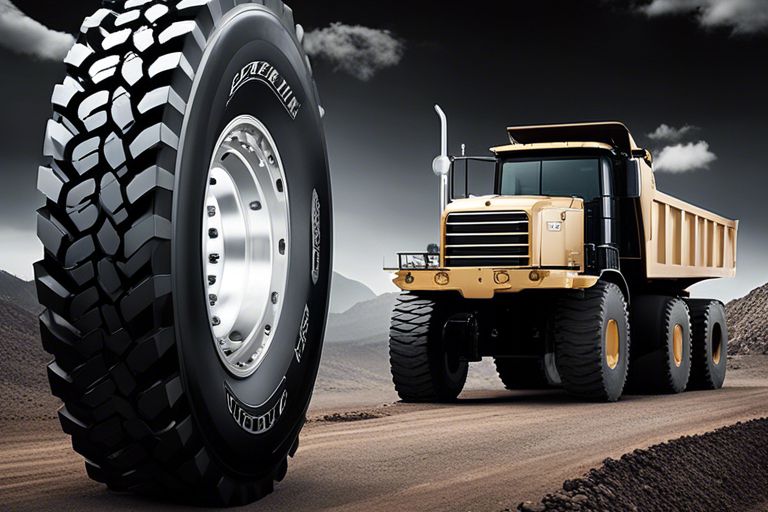
Maintenance and care for a long lifespan
Routine inspections and best practices
For long-lasting performance from your earth-moving tires, routine inspections are crucial. An inspection schedule should be in place to check tire pressure, tread depth, signs of damage and overall condition. Best practices including checking tire pressure regularly, avoiding overload and ensuring proper alignment and tire rotation.
Handling repairs and replacements
When it comes down to it, careful consideration is needed handling repairs And replacements for OTR tires. It is recommended that you consult a professional technician to determine whether a tire can be safely repaired or needs to be replaced. In addition, new tires must be of the same type, size and load rating as the original tires to ensure optimal performance and safety.
Caution is advised when handling repairs And replacements to prevent any risk of further damage or compromise to the integrity of the tire. Any repairs must be made according to industry standards and manufacturer's recommendations to maintain the structural integrity and performance of the tire.
Making the purchase
Where to buy OTR tires
All professionals looking to purchase OTR tires should consider reputable dealers and suppliers. The The most reliable sources for OTR tires are authorized dealers, specialty tire stores, and online retailers that focus on heavy-duty tires. These outlets often have a wide selection of brands and sizes for you to choose from, so you can be sure to find the perfect fit for your specific needs.
When considering where to purchase your OTR tires, it is crucial that you prioritize suppliers with a solid reputation for quality and customer service. The The best sources offer expert advice, competitive pricing and reliable guarantees to ensure you get the best value for your investment.
Evaluate cost versus value
Value is a crucial factor to consider when purchasing OTR tires. While cost is important, it should not be the sole determining factor. Nasty evaluate cost versus value, look for tires that offer durability, performance and longevity. Choosing cheaper tires may save you money up front, but in the long run they could end up costing you more due to frequent replacements and reduced productivity.
When assessing the value of OTR tires, consider the total cost of ownership, including maintenance and potential downtime. It It's worth investing in high-quality tires from reputable brands that offer a balance between cost-effectiveness and performance to ensure optimal results for your heavy equipment.
1. Consider the terrain where the tires will be used.
2. Determine the required loading capacity of the vehicle.
3. Choose the right tire size for optimal performance.
4. Select the correct tread pattern for specific needs.
5. Check the durability and wear resistance of the tire.
6. Compare prices and find the best value for your budget.
Packing up
By following this complete guide to choosing the perfect OTR tires, industry professionals can confidently make informed decisions when selecting the right tires for their specific needs. By considering key factors such as tire size, tread pattern, layer thickness and intended application, professionals can ensure optimal performance and safety for their heavy equipment. Remember to prioritize quality, durability and efficiency to maximize the life and productivity of your OTR tires. With this extensive knowledge, professionals can navigate the options available on the market and select the perfect OTR tires that deliver reliable performance in challenging off-road conditions.
a
FAQ
Q: What factors should I consider when choosing OTR tires?
A: When choosing OTR (Off-The-Road) tires, consider factors such as tread pattern, ply thickness, compound type, tire size and terrain conditions. These factors affect the tire's performance, durability and efficiency in different operating environments.
Question: How do I determine the correct tire size for my equipment?
A: To determine the correct tire size for your equipment, refer to the manufacturer's guidelines or the sidewall markings on the existing tires. Ensure sizing specifications, including width, diameter and rim size, match to ensure proper fit and optimal performance. Consulting with a tire professional can also help select the correct size.
Q: What are some common tread patterns for OTR tires and their applications?
A: Common tread patterns for OTR tires include stone, ridge, rib and smooth. Rock patterns are ideal for rocky terrain, ridge patterns for loose soil, rib patterns for hard surfaces and smooth patterns for industrial and underground applications. Choosing the right tread pattern based on operating conditions will improve traction and overall performance.
